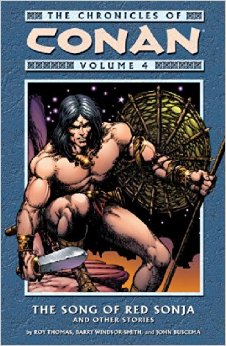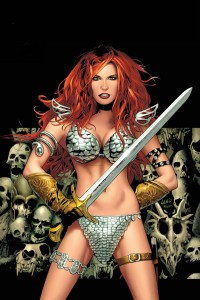
The Chronicles of Conan
Volume 4
The Song of Red Sonja
And Other Stories
At the end of my review of the third volume in Dark Horse’s gorgeous reprintings of the ’seventies Marvel Conan tales, I mentioned that at that point deadlines were becoming rather a problem. It appears that artist Barry Windsor-Smith had turned somewhat fanatical in adding ever-more detail to his panels. As a result, issue #22 was a reprint of the debut comic book. The Holy War of the Tarim wasn’t resumed until The Shadow of the Vulture was cast over issue #23.
Prince Yezdigerd, now solidly encamped outside the city of Makkalet (it is on occasion referred to by the omnipresent narrator as ‘the doomed city’, so we know that it isn’t going to end well for King Eannatum and Queen Melissandra) has brought in the deadliest swordsman in Turan, Mikhal Oglu, known less-than-affectionately as the Vulture. He wants the killer to find Conan and bring him the Cimmerian’s head.
After The Monster of the Monoliths this is a return to form art-wise, although I wasn’t happy with page six, which seemed strange and forced, even in the writing. I felt rather vindicated, therefore, when I read Roy Thomas’s always instructive afterword and learned that in fact Smith never even had a hand in it and that Thomas had the page inserted because he didn’t think that the Vulture’s introduction was dramatic enough. Well, in my opinion it was a bad mistake; not just because it looks out of place but because those little wings that Oglu sports make him look like a cross between a member of the Village People and the fairy on the top of the Christmas tree. No offence to Christmas tree fairies or Village People fans… I’m just saying, like.
The Shadow of the Vulture is loosely based on one of Robert E. Howard’s historical stories –something that Thomas and Smith had become really good at—and is mainly important for introducing Red Sonja, a stunningly beautiful, redheaded, mercenary she-cat in the manner of Howard’s other women warriors, Bêlit of the Black Coast and Valeria of the Red Brotherhood. By the way, whoever says that Robert Howard never created strong women really hasn’t read him.
There is also a nice touch at the story’s climax when Thomas gives a nod to Howard’s poem ‘Cimmeria’.
The Mighty Erection of Conan
And #24 really was Barry Smith’s swan song this time, at least as far as the Conan the Barbarian title was concerned; and here, in the The Song of Red Sonja the warrior woman is given her head. Well, at least the driven-mad-with-lust Cimmerian wishes she would give her head. Alas, Sonja has sworn that no man shalt getteth the leg over her unless he defeats her in battle. And I have to tell you that she’s pretty handy, not only with a sword but with her fists as well.
I’ve always loved Howard’s poetry –some of it actually comes close to being unhinged—and the tale opens with this charming piece of doggerel:
All the world’s a gore rimmed sea,
Lo, the devil laughs with glee.
Come and dance then, you with me—
Come and caper wild and free!
With red blood those fires are lit;
Hades’ smoke is tinged with it!
That’s my Robert. The bulk of the tale is basically Sonja wickedly tempting Conan with her red-hot bod before making a horse’s ass out of him and leaving him limping and sore—and not in a good way. Smith is determined to go out in style and here he not only inks his own work but also colours it. The result is a beautiful piece, although you wonder how it managed to get past the repressive Comics Code, which it was still laboring under. Certainly, Smith packs in the phallic symbols—including a tower that might as well have had I’M A GIANT HARD-ON tattooed over its helmet.
At least he gives Sonja full chain-mail vest to cover her charms with. Later on, especially after she got her own title, the artists had her running around in ridiculous tiny metal bikinis—very nice for fanboy wet-dreams, I would imagine, but not very practical for a woman who gets into as many scrapes as she does.
Although it does give me a chance to print a totally gratuitous image of her.

In the midst of all this excitement there is a beautifully quiet, pathos-filled moment between queen and older king, one that I found very touching when I first read it years ago:
“She rises. For an eternity they stand gazing at each other, groping for the words that have always come so hard to a very young queen and a husband twice her age. At last, they realise that there are no words left to say. So they simply hold each other close, no passion in the embrace but only a tender caring. And, for an instant, there is no Turanian horde battering at the wall of Makkalet, no holy war on which great empires must rise and fall…merely a man grown suddenly older; and a woman, who never was a little girl.”
This time around, when Roy Thomas recounts in the afterword that his first marriage was coming to its end at the time, I found those words more moving than ever.
Enter John Buscema
It’s a pity that Smith hadn’t felt himself able to stay at Marvel long enough to complete issues #25 and #26, since these wound up the seven-issue War of the Tarim sequence. Instead, Big John Buscema was finally brought in. He had in fact been the original choice right at the beginning but the powers-that-be had gone with Barry Smith since he was cheaper! What a difference a few years and awards made.
Well, Smith’s often mouthwatering art was what made Conan the Barbarian but it was under the team of Thomas-Buscema that the title really took off in terms of sales. His style was different. Every panel is kinetic, with characters hardly able to speak without broad, sweeping gestures; and when Conan swings that sword of his you almost feel like ducking. He is bigger and brawnier than ever in Buscema’s pencils, although he certainly looks older than his perhaps twenty-one years. Over all, though, John Buscema quickly fitted in, right from The Mirrors of Kharam Akkad.
This issue is also notable for encapsulating a King Kull tale (and one of my favourite pieces of Howard prose) in two pages, The Mirrors of Tuzun Thune. Kull the Conquer had been given his own title in 1971 but it was nice to see Conan’s ancestor show up here.
Another nice touch from Thomas and again deepening the Conan lore is the look some years ahead to when the Cimmerian will be known as Amra, the feared corsair of the Black Coast.
The Hour of the Griffin wraps up the whole Aghrapur-Makkalet War in style. Thoughts of Vietnam’s infamous My Lai massacre (where American soldiers went completely berserk, destroying an entire village in the process) would then still have been very much affecting the American psyche. I suggested in the review for Volume 3 that perhaps this was Roy Thomas’s nod to the ongoing war in the East. Whether or not that’s true, the fact that his fictional one is a ‘holy war’ amongst easterners gives it a certain unintended resonance for today. And despite that Comics Code, Buscema manages to indicate in one subtle panel what happens to women when a city is sacked.
[Incidentally, proving that some things never change, the barbaric mass murder at My Lai of men, women and children (as well as the livestock) and which included mutilation and gang-rape, saw only 23 American soldiers stand trial and of those only one was convicted—three and a half years under house arrest.]The final page is almost perfect and manages to capture in a single macabre image both the insanity of war and of the religions that often fuel that madness. Much is written about the great anti-war movies and books but here in a not-so-simple comic we have as stark a statement as you could find anywhere.
Red Nails in the Sunset
This was a good point at which to take a break from chronology and reprint Barry Windsor-Smith’s last and arguably greatest outing with the Cimmerian. He manages to capture the sheer obsessive drive and barely contained madness of the first of Robert Howard’s work to appear in Weird Tales shortly following his suicide at the age of thirty. It is violent not only in events but in the actual way in which Howard wrote, which is just impossible to equal, almost screaming from the page as it does.
The barbarian, now in my opinion at the height of his powers as he approached the forty mark, finds himself in a lost city where a perpetual war is waging between two almost extinct groups. It is as brooding as Howard himself was and in an existing letter he ‘jokes’ that he may have been eating too much red meat at the time,
It originally appeared in Savage Tales #2 and 3; and since they were not hampered by the Comics Code this time both Thomas and Windsor-Smith really let loose, giving full rein to the violence. They also had no restriction as regards a page-count and Red Nails finally weighs in at almost sixty.
Howard’s original novella was a masterwork and it is brilliantly served here, in what may be the greatest sword-and-sorcery adventure ever submitted in comic-book form. It is a wonderful farewell to a brilliant writer-artist team.

Recent Comments